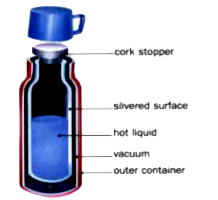Air is bad conductor of heat or partly conducts heat, still vacuum is to be placed between the walls of the thermos flask because
it is difficult to fill the air between the walls of thermo flask
due to more pressure of air, the flask can crack
by convection,heat can flow through air
None of the above
The correct Answer is:C
To answer the question regarding why a vacuum is placed between the walls of a thermos flask, we can break down the explanation into clear steps:
1. Understanding Heat Transfer:
- Heat can be transferred in three ways: conduction, convection, and radiation. In the context of a thermos flask, we are primarily concerned with conduction and convection.
2. Role of Air in Heat Transfer:
- Air is a poor conductor of heat, meaning it does not transfer heat very efficiently. However, it can still facilitate heat transfer through convection, which occurs when warmer air rises and cooler air sinks, creating a circulation of air.
3. Vacuum as an Insulator:
- A vacuum is a space devoid of matter, including air. Since there are no particles in a vacuum, there is no medium for convection to occur. This means that heat cannot be transferred by convection between the inner and outer walls of the thermos flask.
4. Purpose of the Vacuum:
- The vacuum between the walls of the thermos flask serves to minimize heat transfer. By preventing convection (and also conduction to a lesser extent), the vacuum helps maintain the temperature of the contents inside the flask, keeping hot liquids hot and cold liquids cold.
5. Conclusion:
- Therefore, the vacuum is placed between the walls of the thermos flask specifically to prevent heat transfer by convection, ensuring that the temperature of the contents remains stable.
Final Answer:
The vacuum is placed between the walls of the thermos flask to prevent heat transfer by convection, as there is no medium in a vacuum to facilitate this process.
---
- Heat can be transferred in three ways: conduction, convection, and radiation. In the context of a thermos flask, we are primarily concerned with conduction and convection.
- Air is a poor conductor of heat, meaning it does not transfer heat very efficiently. However, it can still facilitate heat transfer through convection, which occurs when warmer air rises and cooler air sinks, creating a circulation of air.
- A vacuum is a space devoid of matter, including air. Since there are no particles in a vacuum, there is no medium for convection to occur. This means that heat cannot be transferred by convection between the inner and outer walls of the thermos flask.
- The vacuum between the walls of the thermos flask serves to minimize heat transfer. By preventing convection (and also conduction to a lesser extent), the vacuum helps maintain the temperature of the contents inside the flask, keeping hot liquids hot and cold liquids cold.
- Therefore, the vacuum is placed between the walls of the thermos flask specifically to prevent heat transfer by convection, ensuring that the temperature of the contents remains stable.
The vacuum is placed between the walls of the thermos flask to prevent heat transfer by convection, as there is no medium in a vacuum to facilitate this process.
Topper's Solved these Questions
- BOOK - DC PANDEY ENGLISHCHAPTER - CALORIMETRY AND HEAT TRANSFEREXERCISE - Taking it together51videos
CALORIMETRY AND HEAT TRANSFER
- BOOK - DC PANDEY ENGLISHCHAPTER - CALORIMETRY AND HEAT TRANSFEREXERCISE - Assertion and reason17videos
CALORIMETRY AND HEAT TRANSFER
- BOOK - DC PANDEY ENGLISHCHAPTER - CALORIMETRY AND HEAT TRANSFEREXERCISE - Check points 16.320videos
CALORIMETRY AND HEAT TRANSFER
- BOOK - DC PANDEY ENGLISHCHAPTER - CALORIMETRY & HEAT TRANSFEREXERCISE - Level 2 Subjective14videos
CALORIMETRY & HEAT TRANSFER
- BOOK - DC PANDEY ENGLISHCHAPTER - CENTRE OF MASSEXERCISE - Medical entrances gallery27videos
CENTRE OF MASS
Similar Questions
Knowledge Check
- Question 1 - Select One
The vacuum kept in between the walls of a thermos flask reduces the heat transfer by :
Aconduction onlyBconvection onlyCradiation onlyDconduction and convection.
Look at the picture of the thermos flask and answer the following question
 Which means of heat transfer are prevented by having a vacuum between the two walls of thermos flasks?View Solution
Which means of heat transfer are prevented by having a vacuum between the two walls of thermos flasks?View SolutionWater and air are good conductors of heat .
View SolutionDistinguish between Good conductors and bad conductors of heat
View SolutionLook at the picture of the thermos flask and answer the following question

The outer surface of the inner wall of a thermos flask has a very shiny surface. What effect will this have on heat escaping from a hot liquid inside a thermos flask?View SolutionWrite two applications of bad conductors of heat.
View SolutionAssertion : Good conductors of electricity are also good conductors of heat due to large number of free electrons.
Reason : It is easy to conduct heat from free electrons.View SolutionWhy is diamond a bad conductor of electricity but a good conductor of heat?
View Solution

